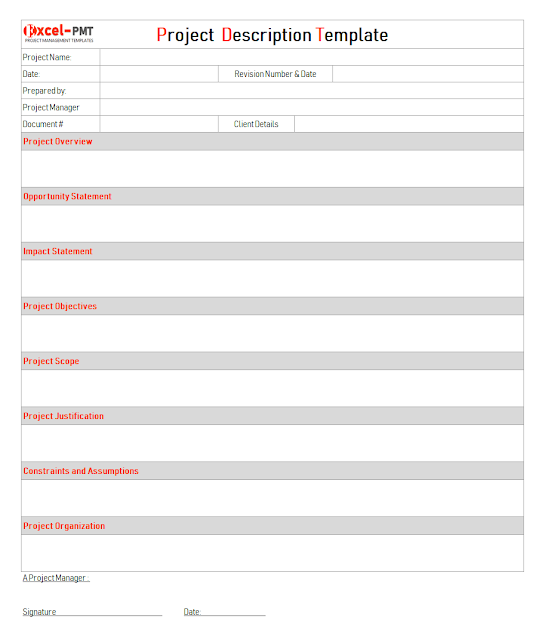A project description is formal document may declare of a project with deep explanation of the goals, objectives and outline entire project steps. The project description document may address the clear and detailed information about entire works and activities in written form.
The Project Manager communicates the vision for the effort and certifies the initial Project Description. Should changes be required, the Project Manager confirms these changes and their influence on the Project Charter and Project Plan.
When project decisions cannot be made at the team level, the Project Manager must resolve these issues. The Project Manager must play an active role throughout their project, especially insuring that needed resources have been committed to the project and remain available.
What to include in the project description sample template?
Project Overview
The Project Overview provides a brief summary of the entire Project Description. It may provide a brief history of the events that led to the project, an explanation of why the project needs to be initiated, a description of project intent and identifies the original Project Manager.
Project Organization
The Project Organization identifies the roles and responsibilities needed to create a meaningful and responsive structure that enables the project to be successful. This Project Organization must identify the people who will play each assigned role.
Opportunity Statement
The Opportunity Statement identifies the most significant business reasons for performing a project. This may include a vision for future project deliverables, a list of anticipated features, a list of expected advantages.
Impact Statement
Impact Statement identifies the influence the project may have on the business, operations, schedule, other projects, current technology and other applications.
Project Objectives
Project Objectives identify measurable criteria that must be satisfied before the project is considered complete.
Project Scope
Project Scope identifies the boundaries for the project. Specific scope components are the business areas or functions to be examined by the project (Domain of Study) and the work that will be performed (Domain of Effort). The Project Scope should identify what is in scope and what is not in scope.
Project Justification
Project Justifications provide a recap of known cost and benefits from performing the project. These factors may be more fully defined in a Project Cost/Benefit Worksheet. The project financials must be re-forecast during the life of the project and should be compared to actual at the conclusion of the effort. Some of the listed items are tangible (priced) and others intangible (un-priced).
Constraints and Assumptions
Constraints and Assumptions identify any deliberate or implied limitations or restrictions placed on the project along with any current or future environment the project must accommodate. These factors will influence many project decisions and strategies. The potential impact of each constraint or assumptions should be identified here.
Project Manager
A Project Manager is required for each project. This role must be filled by one or more individuals who are the fiscal trustee for the project to the larger corporate organization. This function considers the global impact of the project and deems it worthy of the required expenditure of money and time.The Project Manager communicates the vision for the effort and certifies the initial Project Description. Should changes be required, the Project Manager confirms these changes and their influence on the Project Charter and Project Plan.
When project decisions cannot be made at the team level, the Project Manager must resolve these issues. The Project Manager must play an active role throughout their project, especially insuring that needed resources have been committed to the project and remain available.








ReplyDeleteAmazing one!
Worth Stuff thanks for sharing.
Selective school mock test
I'm completely glad to visit your blog. At this point I have found what I genuinely care about. I truly look at your blog ordinary and try to obtain something from your blog.
ReplyDeletePermanent Staffing Agency
Payroll Outsourcing Agency
Staffing Agency
Recruitment Agencies in India
NAPS
NATS Apprenticeship